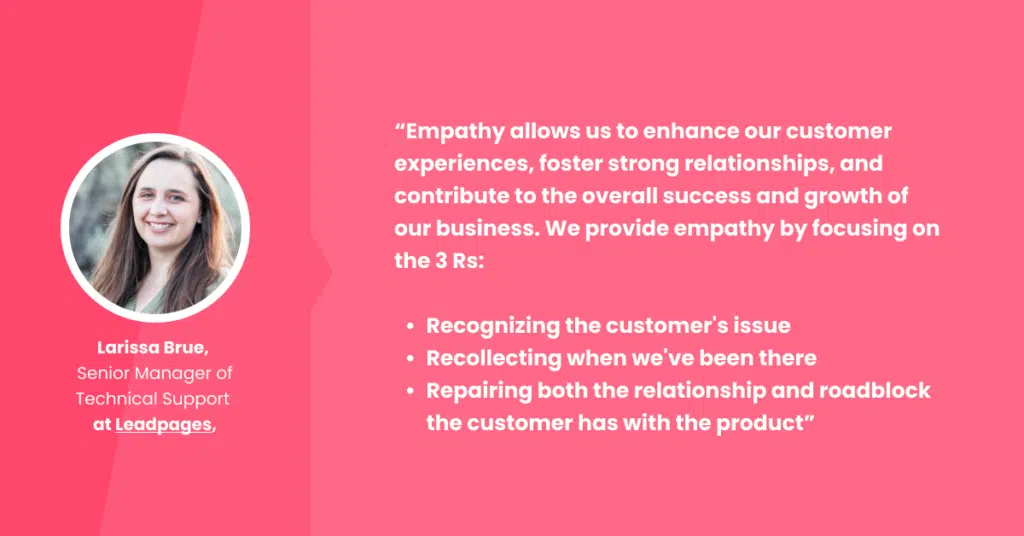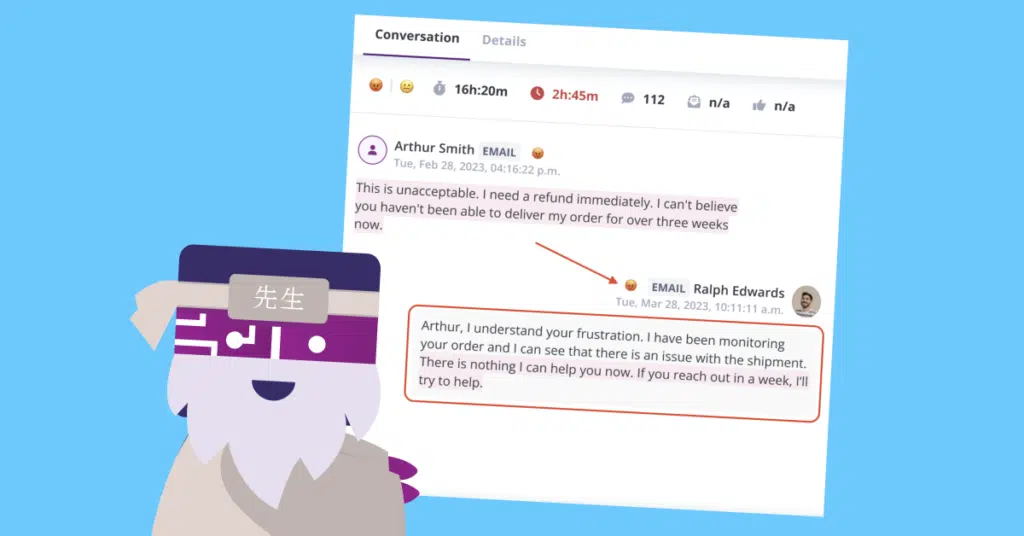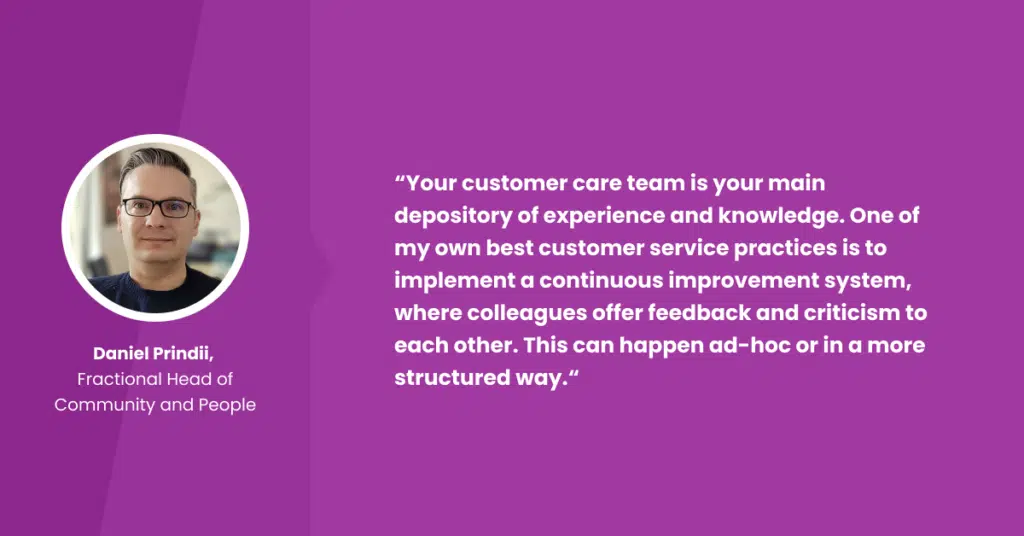Over two-thirds of individuals expect more from customer service now than they did three to five years ago, a recent report has found.
This means you’ve got to re-think the way you run your own customer service efforts.
It’s also one of the reasons why you’re not tapping into the full potential of your agents.
So we’re sharing 6 new customer service practices that will help you optimize the work of your managers and QA raters as well as support centers in general.
Doubling down on empathy
A majority of consumers (59%) believe that businesses have become disconnected from the human aspect of providing customer service.
In a world where empathy is lacking, adding this element to your support services builds trust and rapport between the customer and the business.
And a handful of companies are actually prioritizing empathy among their best customer support practices.
Larissa Brue, Senior Manager of Technical Support at Leadpages, says they’re staying dedicated to delivering exceptional support by practicing empathy in every customer interaction:
“Empathy allows us to enhance our customer experiences, foster strong relationships, and contribute to the overall success and growth of our business. We provide empathy by focusing on the 3 Rs:
- Recognizing the customer’s issue
- Recollecting when we’ve been there
- Repairing both the relationship and roadblock the customer has with the product”

Recognizing the customer’s issue in a support context means identifying and acknowledging the problem or concern they’re facing. It involves actively listening to the customer’s description of their issue and demonstrating understanding and compassion.
Recollection allows agents to draw from past experiences to better understand and relate to the customer’s situation. You can use those personal experiences to empathize with their frustration and confusion, which allows organizations to build stronger relationships with customers.
Once you’ve recognized the issue and empathized with them, the next recommended best practice in customer service is to take action and address the problem with care, respect, and professionalism.
Kaizo’s Agent Empathy Score uses AI to objectively assess and quantify the empathy levels that agents showcase during customer interactions. This removes the possibility of bias from manual ratings, ensuring consistent scores for each engagement and agent.

Kaizo’s AI provides a powerful analysis of sentiment and empathy in messages by automatically highlighting negative sentiment and empathy. With this feature, you can evaluate the accuracy of the analysis conducted, giving you greater control and understanding of how the Sentiment and Empathy analysis works.
Leverage Auto QA
Building a self-service knowledge base, trying out chatbots, automating notifications you send to customers…
These are all great ways to automate and speed up your communication with prospects and clients.
But what are you doing within your own teams?
QA raters should use automated quality assurance to identify potential areas of improvement. For example, if there’s a large discrepancy between manual and automated results, this could be an indication that the QA rater either does not fully understand the criteria they’re assessing or is not adhering to the guidelines that have been established.
Kaizo’s Ticket Filtering feature lets you customize the types of tickets you prioritize when assessing your agents’ performance. You can select these preferences through three different parameters: tags, channels, and metrics. Kaizo will then remove any tickets that don’t meet your criteria, allowing you to focus on the cases that fit your specifications.
Kaizo’s Samurai then allows you to rate 100% of these tickets in real-time and instantly find issues by analyzing root causes. Managers can also easily spot low customer and agent sentiments and see critical tickets for review instantly.

Prioritize video
Videos are a great way to provide customer support because they allow customers to quickly and easily access information about a product or service.
These allow customers to experience a more interactive process than text, understand complex topics easier, and even get solutions faster.
Darren Chait, Head of Growth at Calendly and former Co-Founder and COO of Hugo, revealed to us that he regularly relies on video to increase the bandwidth of support conversations.
Darren pointed out that prioritizing video support over text provides two major advantages. The first is the “bandwidth” of communication, which refers to the amount of data that can be transmitted in a certain period of time.
Video platforms like Loom and Zoom allow for much more information to be exchanged quickly compared to email or live chat, and screen sharing further increases the efficiency of communication.
At Hugo, a Zoom call only took a minute, as compared to a 1 or 5-minute text conversation, allowing support staff to get a better understanding of the customer’s issue.
This understanding then allowed the support person to effectively provide a solution with a single reply, which would not be possible via chat within the same time frame. Therefore, by offering video support, Hugo was able to save time and provide a better customer experience.
Hugo’s founders also placed great importance on providing pre-recorded and live video support as one of their core best customer service practices. Seeing a friendly face over video, rather than simply reading text, can make a much more powerful impression and could be enough to persuade customers to transition from a trial to a full-paying customer.
To do so, Hugo focused on candidates who had strong oral communication skills during their customer service hiring process. They were more selective and had a stringent testing system to ensure that new hires would be able to effectively represent the company in face-to-face customer interactions.
Make place for gamification
Another one of the current best practices in customer service is to try out gamification for addressing customer support challenges.
Using gamification to tackle challenges can help agents and managers feel a sense of achievement at the end of every week, instead of waiting for months for projects to be completed. Additionally, gamification provides instant gratification and the satisfaction of reaching consistent milestones.
Tip: To use gamification right, set attainable objectives. Making sure that the tasks aren’t too challenging will help the ‘player’ feel accomplished and reassure them that they’re working towards meaningful metrics.
With Kaizo’s gamification and personalized ninja avatars, you can motivate agents and reward their successes in an instant. This makes it easier for you as a manager or team lead to identify which agents to recognize for their accomplishments and which ones could benefit from additional guidance.
Scale your efforts based on what your customers want
A positive customer experience is essential as 65% of people find a positive customer experience to be more influential than brilliant advertising.
A better overall customer experience includes ensuring that customer support is available during peak times, responding promptly to customer inquiries, and providing personalized customer service. These are all areas you need to prioritize if you want to increase customer satisfaction and boost loyalty.
Dutta Satadip, Chief Customer Officer at ActiveCampaign, says that in order to optimize your business’s processes so they’ll enhance customers’ experiences, you need to develop the right teams, encourage collaboration, maintain open communication with customers, and provide employees with the resources needed to excel.
Here’s Dutta’s own quick exercise that you can also implement:
“When you go global, you can’t dedicate yourself to one-on-one time with customers. Always ask yourself, ‘What are you trying to do? Who were my customers first?’ This exercise helps you understand where your product shines and which industry your offering works best in as you scale.”

Dutta further noted that it’s important to establish reasonable expectations for customers right away to make sure that they can still be met when you expand. If, for instance, you initially promised customers individual coaching, it would be impossible to provide this service on a global scale. Therefore, it’s essential to set realistic expectations from the beginning.
Kaizo’s Customer Sentiment metric gives you the ability to gain valuable insights into the overall customer experience. By analyzing tickets, you can recognize both verbal and non-verbal cues to evaluate customer satisfaction and improve service quality. With this metric, you can pinpoint areas that require improvement and any underlying issues that need to be addressed.
It also offers a more comprehensive evaluation of customer sentiment than traditional customer satisfaction ratings. It can quickly detect any negative sentiment, allowing for swift problem resolution and improved customer satisfaction. Additionally, it helps you provide support agents with feedback on their performance, enabling them to receive targeted training and further develop their skills.
Tap into your team’s expertise
Before you think of what you can improve in the way you communicate with customers, take a moment to better understand if you’re doing enough for your own agents first.
Daniel Prindii, Fractional Head of Community and People, says you should put your agents first at all times:
“Your customer care team is your main depository of experience and knowledge. One of my own best customer service practices is to implement a continuous improvement system, where colleagues offer feedback and criticism to each other. This can happen ad-hoc or in a more structured way.“

Here’s a checklist of ways in which you can help your agents grow:
- Find out as much as you can about how your agents currently perform by taking a look at the entire ticket funnel
- Analyze the expertise of employees within the customer service team to determine which topics and product areas they’re best suited to handle
- Create a system to track and manage customer support requests, topics, and employee expertise.
- Implement a reward system to recognize and motivate employees for delivering excellent customer service
- Connect the customer service team with other departments in the organization
- Schedule regular meetings to evaluate performance and discuss the best practices for customer service
- Develop an ongoing training or coaching program to ensure customer service agents stay up-to-date on industry trends and techniques
Challenge your agents by setting personalized goals for them with AI Missions.

Automated Missions save team leads time which can be spent on other tasks. Agents can also receive their Mission quickly. Achievable goals motivate agents and keep them engaged. In other words, you’re giving agents a clear roadmap to success, aligning their efforts with your own organizational goals.
Starting from your people will ultimately be the stepping stone for improving your customer service operations in the upcoming years.
Want to see what the future could look like for you? Give Kaizo a try to start implementing these customer service best practices!



